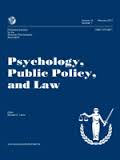 “Learning legal rules, which provide explicit direction as to the correct outcome of a case, should reduce the impact of stereotyping; learning legal standards, which require decision-makers to draw inferences from the facts of a case, should not.” This is the bottom line of a recently published article in Psychology, Public Policy and Law. Below is a summary of the research and findings as well as a translation of this research into practice.
“Learning legal rules, which provide explicit direction as to the correct outcome of a case, should reduce the impact of stereotyping; learning legal standards, which require decision-makers to draw inferences from the facts of a case, should not.” This is the bottom line of a recently published article in Psychology, Public Policy and Law. Below is a summary of the research and findings as well as a translation of this research into practice.

Featured Article | Psychology, Public Policy and Law | 2016, Vol. 22, No. 1, 31-45
Wise Restraints?: Learning Legal Rules, Not Standards, Reduces the Effects of Stereotypes in Legal Decision-Making
Authors
Erik J. Girvan, University of Oregon School of Law
Abstract
Does studying the law reduce bias from stereotypes in legal decision-making? Psychological, psychometric, and jurisprudential theory suggest that the answer depends on the form of the relevant legal doctrine: Learning legal rules, which provide explicit direction as to the correct outcome of a case, should reduce the impact of stereotyping; learning legal standards, which require decision-makers to draw inferences from the facts of a case, should not. The results of 2 experimental studies involving undergraduates and law students provide strong support for this theory. In each, consistent with the predictions of the Stereotype Content Model, participants tended to decide cases for the party that was rated by an independent sample to be associated with stereotypically warmer traits unless the participants had learned legal rules and were deciding cases with facts to which those rules applied. Learning legal standards did not moderate this effect. The findings provide additional support for the distinction between rules and standards in law and can inform the public policy decisions between which is most beneficial.
Keywords
legal education, legal judgment and decision-making, rules and standards, stereotype content model, tort law
Summary of the Research
The results of empirical research regarding the question of if “legal education make[s] people unbiased decision-makers” are mixed. Over the past decade, some researchers have found that implicit and explicit biases do not impact the decision making process of individuals with legal training and mock jurors. However, some findings have indicated that racial biases impacted the decision-making process of law firm partners and professional arbitrators. Given these contrary findings, the current study examined the effects of legal education on bias. Specifically, the author theorized that “legal education is likely a conditional moderator of bias from stereotypes. Studying legal doctrines will only attenuate the effects of stereotyping when those doctrines provide specific guidance as to the correct outcome in the cases being decided. If the doctrines provide only general guidance that requires decision-makers to draw inferences and make discretionary judgments, then stereotypes will impact the decisions of even those with legal training” (p. 32).
“Stereotypes are associations between the groups into which people are categorized (e.g., African American, man, mother) and certain characteristics that members of those groups are believed to have (e.g., athleticism, criminality, and an affinity for jazz and rap music; affinity for science and leadership; nurturing and caregiving). Stereotypes need not have any basis in reality. But even when they are factually accurate at the group level, people tend to overestimate the extent to which stereotypes apply to particular individual members of a group. Moreover, stereotypes are socially shared and thus represent a common perspective, not idiosyncratic, individually held beliefs. As a result, the impacts of stereotypes tend to be systematic…Because of the enormous variety in the groups and subgroups about which there are stereotypes, broad statements about how stereotypes impact particular decisions can be difficult to make. The Stereotype Content Model (SCM) attempts to resolve this issue by mapping the stereotypes about any group or subgroup onto two dimensions: Warmth and competence. Warmth, the primary and most influential dimension, represents an assessment of the intentions, good or bad, of others. Competence is secondary, relating to the perceived efficacy of members of that group. On average, people are more likely to help, or facilitate the goals of, members of groups that are stereotypically associated with warmer traits (e.g., for U.S. adults this includes housewives, the elderly, and middle-class Americans). Conversely, people will tend to harm, or work against the goals of, those from groups that are stereotypically associated with traits low in warmth (for U.S. adults this includes Arabs and the homeless). Assessments of competence, in turn, predict passive behaviors: People are more likely to passively assist (i.e., go along with) those from groups seen as high in competence (e.g., the rich) but passively harm (i.e., neglect) members of groups viewed as low in competence (e.g., the elderly, those with developmental disabilities)” (p. 32).
“In jurisprudential theory, the potential extent of bias in law is frequently associated with a distinction in the form of legal doctrine: Rules versus standards. Rules are inflexible and determinative in the sense that they ‘attempt to specify outcomes before particular cases arise’ leaving little or no room for discretion or interpretation. Standards, by comparison, are flexible and indeterminate in that, to make a decision, the person applying the doctrine must figure out what it means in the context of the facts of a particular situation… When a rule governs a given situation, application is straight- forward and the correct outcome generally constrained and highly predictable. As a result, rules are thought to reduce or eliminate errors in judgment, including those caused by biases” (p. 32-33).
“The jurisprudential, psychometric, and social psychological theory together suggest that learning the law is most likely to result in unbiased decisions when application of the learned legal doctrines provide students with explicit direction as to the correct or appropriate outcome of a particular case. By comparison, legal education is unlikely to have any effect on stereotyping when the doctrines require those who have learned them to draw additional inferences in the context of a specific case otherwise involves a set of discretionary judgments” (p. 33).
“The hypotheses were tested with two experimental studies involving participants’ liability decisions on a set of 24 mock tort cases… The facts of each of the 24 mock cases were based on the facts of an actual tort case, the outcome of which was affirmed on appeal. Across the cases, the applicability of rules and standards was a within-subjects factor: Half of the mock tort cases were selected from cases decided and affirmed on the basis of a legal rule that the court had applied to the facts in that case and the other half decided and affirmed based upon application of a legal standard to the facts of the case. In addition, to avoid confounding the relevant doctrine with outcome, half of the cases decided with rules and half of those decided with standards were selected from cases decided in favor of the plaintiff and the other half those decided for the defendant” (p.34)
In the first study, 155 undergraduates were trained in varying levels on the legal doctrines involved (all, some, none). The design was then repeated with a sample of 77 law students who had taken a tort law class. Both groups read and decided 24 case vignettes which were manipulated based on the stereotypes of warmth described above. “Across the mock cases, in half of the cases the names and other descriptions of the parties were altered to suggest that, the defendant(s) belonged to a group stereotypically associated by U.S. adults with warmer traits and the plaintiff(s) belonged to a group stereotypically associated with less warm traits. In the other half, the names and descriptions of the parties were altered to produce the opposite pattern, that is, plaintiff(s) with stereotypically warmer traits than defendant(s)” (p. 34).
“Together the results of Studies 1 and 2 provide strong support for the idea that the de-biasing influence of a legal education is conditional. In both studies, when participants had no training, training on doctrine that did not apply to the case, or training on and were deciding cases to which legal standards applied, stereotypic warmth had a significant positive influence on case outcomes. The only situation in which stereotypic warmth ratings did not have a significant positive impact on the decisions was where participants were trained in legal rules and were deciding cases with facts to which legal rules applied. In those decisions, the relative stereotypic warmth of the parties was actually a negative predictor of participants’ liability decisions” (p. 41).
Translating Research into Practice
“Jurisprudential scholars not only recognize the distinction between rules and standards but frequently debate which is preferable. As noted above, in the debate, rules are thought to limit the impact individual judges’ biases have on their particular decisions at the expense of flexibility and standards assumed to retain case-specific flexibility at the potential expense of bias. Although routinely made, however, such observations about rules and standards are most frequently offered without supporting empirical evidence. The results reported here fill this gap and provide an often neglected psychological and empirical foundation for the assertion that rules have a comparative advantage over standards in reducing the impact of bias on legal decisions” (p. 41).
“The results also provide a concrete estimate of the comparative advantage of rules over standards in reducing bias from stereotyping. The final outcomes of the cases were approximately 1.5 times as likely to be stereotype consistent when trained participants were deciding cases with facts to which a legal standard applied as when they were deciding cases using a legal rule. This is, itself, a potentially important effect. But it may not just be the ultimate liability decisions that policymakers need to be concerned about” (p. 42)
“Lawyers are the gatekeepers for civil claims. Their perceptions of the strength of a potential claim impacts whether they agree to take the case, the time and energy it merits, and whether it is settled and for how much. To the extent these initial liability decisions are themselves impacted by stereotyping, the bias may create or exacerbate disparities in the availability of legal services, access to justice, and thus the meaningful protection of substantive rights” (p. 42).
“In the end, there may be very good reasons for flexible substantive and procedure doctrine. But when debating which is better, knowing the breadth and magnitude of the cost that selecting standards may systematically impose on members of society who belong to groups that are not associated with stereotypically warm traits could potentially tip the balance. Even if not, it should result in a better informed decision” (p. 43).
“The findings in this study provide “strong support for the idea that the de-biasing effect of studying the law is contingent upon the relevant content of the legal doctrine: Rules or standards. Although additional research is needed to validate and extend them, the results have the potential to help us to better understand and quantify the social costs and benefits of policy decisions regarding how to structure legal doctrine. Moreover, it can improve the ability of policymakers and those administering the legal system to target scarce resources toward areas of legal decision-making that are likely to be particularly vulnerable to bias from stereotyping. In doing so, at least with respect to such bias, this insight may help us to work toward the ideal of law as a system of wise restraints that make us free” (p. 43).
Other Interesting Tidbits for Researchers and Clinicians
“One of the barriers to research on bias in professional legal decision-making is difficulty getting access to or consent of judges and jurors. The approach used here circumvents this barrier. Most hearings and trials are open to the public. By having research assistants, blind to hypothesis, attend a hearing or trial and complete a few measures of the warmth of the parties, counsel, witnesses, or others involved, researchers could attempt to replicate these findings, or test other hypotheses related to stereotype use, in the courtroom” (p. 41).
“Although the results of Studies 1 and 2 suggest that the findings generalize to different populations, the training, samples, and decision tasks used in the studies were necessarily laboratory approximations of real-world legal decisions. Additional studies will need to address this shortcoming through conceptual replication of the studies in other types of decisions common in the legal system (e.g., child welfare decisions, decisions in small-claims court, case management and triage) and samples with more experience (e.g., judges and practicing attorneys). Converging results from such studies would provide very strong support for the conditional de-biasing effect of legal education on decision-making in this context” (p. 42).
Join the Discussion
As always, please join the discussion below if you have thoughts or comments to add!





















